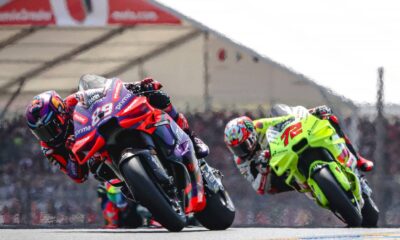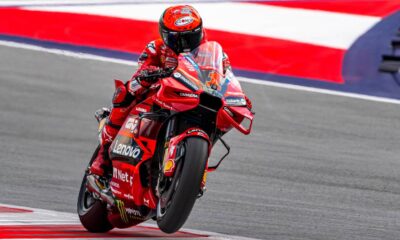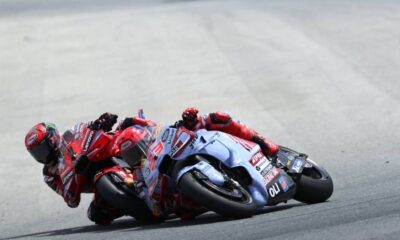Motorsport
From weaving mill to MotoGP or How Michio Suzuki came to racing. What is the story of one of the most famous brands in MotoGP?
Suzuki is one of the best known brands in MotoGP and has already made a significant mark on the royal cubature. In short, the Japanese team has a history, which makes the announcement of its departure from MotoGP at the end of the 2022 season all the more shocking. However, there is a very interesting story behind this stable.

Suzuki is one of the best known brands in MotoGP and has already made a significant mark on the royal cubature. In short, the Japanese team has a history, which makes the announcement of its departure from MotoGP at the end of the 2022 season all the more shocking. However, there is a very interesting story behind this stable.
Suzuki has its historical roots in another industry, far removed from motorcycles and racing. Founder Michio Suzuki was the quintessential innovator, who in 1909 built a weaving mill called Suzuki Loom Works in the small coastal town of Hamamatsu in Shizuoka, Japan. Perhaps needless to say, they concentrated on the production of cotton fabric.
However, World War II and the post-war period left Suzuki in crisis, resulting in a major restructuring. In 1952, as a result of this uncertainty, they decided to produce their first motorcycle. Suzuki first entered motorcycle racing in 1960.
And even then, the brand set a very audacious goal – to win the infamous Isle of Man TT, which has always been one of the toughest races in the world.
In their first ever motorcycle race, Suzuki scored a solid success as all three of their motorcycles completed this very tough event. As it later turned out, a very important part of the Japanese brand was rider Ernst Degner, thanks to whom Suzuki scored its first victory at the 1962 Isle of Man TT.
It should be noted Degner joined Suzuki in 1961 after fleeing East Germany and was instrumental in the development of Suzuki’s first motorcycles. The Japanese team took its first win in the 125cc class at the end of the 1962 season, thanks to former rugby player Hugh Anderson. This was in the Argentine Grand Prix at a circuit called the Autódromo Oscar Alfredo Gálvez.
16 championship titles since 1962
Since 1962, Suzuki has collected a total of 16 world championship titles, with multiple victories in each decade. Unsurpassed in the 1960s was New Zealander Anderson. In fact, he won the 125cc class world championship in 1963 and 1965, and the 50cc class in 1963 and 1964.
However, 1963 was special for Suzuki in another respect. Development engineer Mitsuo Itoh scored an extraordinary victory at the Isle of Man TT. And why extraordinary? His achievement has gone down in history in bold print. That’s because Itoh became the first and last Japanese rider to conquer the race’s dangerous roads.
Anderson’s success was followed by Hans-Georg Anscheidt. The German-born rider rode the RK66, a two-cylinder prototype capable of reaching speeds of 170 km/h. He confirmed his dominance in the 50cc class three times in a row, from 1966 to 1968.
70. and the 1980s marked by more titles and the first victory
Suzuki had to wait two years for another major triumph when Dieter Braun dominated the 1970 season. However, 1971 was also a major milestone for Suzuki. It was then that the Japanese team scored its first victory in the 500cc category.
And this famous Suzuki moment was made possible by Australian racer Jack Findley, who became the first man to win a 500cc race on a two-stroke motorcycle. In the 1970s, Suzuki thus completed its inspirational story. British rider Barry Sheene brought a fresh wind to motorcycle racing and became a celebrity off the track.
In any case, Sheene took Suzuki to the very top in the 1976 season, allowing the Japanese marque to celebrate its cubicle royalty title. It should be noted, Sheene did this with the now legendary RG500 motorcycle. A year later, he dominated the championship again.
Suzuki was on top and enjoying a golden era. But the Japanese brand wanted to continue to dominate the world of motorcycle racing, so it teamed up with former racer Roberto Gallini, who wanted his own team in the world championship. Moreover, the association with the Italians also made sense in terms of facilities, as Gallini had plenty of resources at his disposal.
Marko Lucchinelli, who shared the same lifestyle as Sheene and was a great friend of his, then became his successor. Sheen in fact left the Suzuki factory team after the 1979 season to join Yamaha. And he did so thinking he was getting worse equipment than his teammates. In fact, his duel with Silverstone’s Kenny Roberts (1979) is still remembered today, with Roberts becoming world champion three times in a row, from 1978-1980.
Suzuki returned to the throne in 1981, when it won the world title on the RG500 motorcycle. Lucchinelli was then nicknamed ‘Crazy Horse’ for his wild style, but it was this that also led him to his dream championship.
A year later, Suzuki won another title. Italy’s Franco Uncini won five Grands Prix in the 1982 season and was on the podium seven times. At a time when names such as Sheen, Roberts and Freddie Spencer were racing in the Royal Cubat, it was an all the sweeter triumph.
90. the years, the art of Shwantz
Kevin Schwantz was another undisputed Suzuki talent who possessed one of the most amazing riding styles in MotoGP history. It was this rider who made history by beating Wayne Rainey’s Yamaha to win the World Championship in 1993. Schwantz also ended Suzuki’s long wait for a title with this one, just since the days of Italians Uncini and Lucchinello.
Kenny Roberts Jr.
Suzuki’s next championship title came 7 years later when Roberts Jr, son of the famous king, took the 500cc World Championship. It was the sixth Premier Class win for the Japanese marque, and the title was special in another respect. Roberts Jr. beat the then young and very talented Valentino Rossi that year.
The modern era
In 2002, the World Road Motorcycle Championship was renamed MotoGP, but this was not the only change. Along with the entry into the new era came new technical rules, the most notable part of which was the introduction of 1000cc four-strokes. It was clear that all manufacturers would therefore focus their development in this direction. Suzuki, however, had to wait for victory in the new era.
That was until 2007, when Australian Chris Vermeulen secured an impressive victory for the Rizla Suzuki team in the rain-soaked French Grand Prix at Le Mans. It was also a feat that earned him his first career MotoGP victory.
Then in 2011, the Japanese marque left the MotoGP world, mainly due to financial difficulties. In 2015, however, it returned to the royal cubature with the Suzuki Ecstar team. With a completely rebuilt concept, it should be noted.
Suzuki scored its first win after a spectacular comeback in 2016 on the occasion of the British Grand Prix at Silverstone. Maverick Viñales took the top spot then. The 2019 season was a great one for Suzuki, with Alex Rins managing to win two races (Austin and Silverstone) and finishing fourth in the final Drivers’ Championship standings.
The absolute breakthrough season, however, came in 2020, when Spaniard Joan Mir became world champion. The Spanish racer put together a sensational season. He showed consistency and maturity throughout the year and returned Suzuki to the centre of the action after twenty years. He was rightly crowned world champion.
Combined with Rins’ impressive form, it was a truly spectacular comeback. But this feat was compounded by the celebration of 100 years since Suzuki’s founding and 60 years since its entry into motorcycle sport.
The 2021 season, however, was not nearly as satisfying. Although Mir finished third in the final riders’ championship standings, his teammate Rins scored only 99 points to finish 13th. In the team standings, Suzuki finished third with 307 points. However, they lost 73 points to second-placed Yamaha and an abysmal 126 points to first-placed Ducati.
At the start of the 2022 season, Suzuki announced its retirement from MotoGP. Unfortunately, the current economic situation and the need to focus its efforts on the major changes facing the automotive world in these years has forced Suzuki to drastically reduce the costs associated with racing and to use all its economic and human resources to develop new technologies.
Sources: Team Suzuki Ecstar, MotoGP






